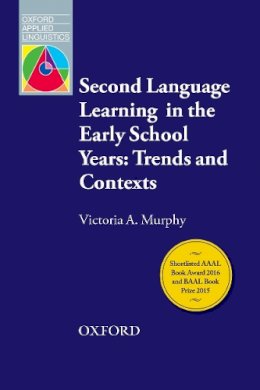
Stock image for illustration purposes only - book cover, edition or condition may vary.
Second Language Learning in the Early School Years: Trends and Contexts (Oxford Applied Linguistics)
Victoria A. Murphy
€ 75.05
FREE Delivery in Ireland
Description for Second Language Learning in the Early School Years: Trends and Contexts (Oxford Applied Linguistics)
Paperback. Num Pages: 223 pages. BIC Classification: 2AB; EBA. Category: (L) ELT / TEFL. Dimension: 158 x 242 x 14. Weight in Grams: 350.
Second Language Learning in the Early School Years: Trends and Contexts provides a detailed exploration of second language learning in the early years, examining past and present research evidence on bilingualism, second language, and foreign language learning in childhood, and arguing that young children can learn multiple languages without adverse effect on their overall language development in any of their languages.
Second Language Learning in the Early School Years: Trends and Contexts provides a detailed exploration of second language learning in the early years, examining past and present research evidence on bilingualism, second language, and foreign language learning in childhood, and arguing that young children can learn multiple languages without adverse effect on their overall language development in any of their languages.
Product Details
Publisher
Oxford University Press
Format
Paperback
Publication date
2014
Series
Oxford Applied Linguistics
Condition
New
Number of Pages
223
Place of Publication
Oxford, United Kingdom
ISBN
9780194348850
SKU
V9780194348850
Shipping Time
Usually ships in 15 to 20 working days
Ref
99-30
About Victoria A. Murphy
Victoria A. Murphy is Associate Professor in Applied Linguistics and Second Language Acquisition at the Department of Education, University of Oxford, and leads the Research in English as an Additional Language research team.
Reviews for Second Language Learning in the Early School Years: Trends and Contexts (Oxford Applied Linguistics)
'Murphy provides a systematic analysis of different second language learning contexts involving younger learners, closely examining the strengths and weaknesses of these contexts. She also provides useful practical and conceptual guidance for a better understanding of these contexts, with the conviction that bilingualism is an asset. Consequently, from whatever the setting and position the reader is in, this is definitively a book to read and to keep close-by for an informative and consistent "bird's-eye view" of young second language learners.'
International Journal of Applied Linguistics
'It is refreshing to read a book about young children learning languages that lives fully up to its title... In this book, although English receives a sizeable amount of attention, it is not the only language treated and we are taken into an array of different social and political circumstances in which learning a language is central to a child's wellbeing...The reports of research in this book set up comparisons and contrasts that offer valuable new insights and areas for reflection... The book's major contribution is that it attempts to gather together research and to make the point that when we are dealing with school-based learning, there is much in the messiness of the contexts of real life to obscure or enrich what the Age Factor brings to the debate and much that we can do through the use of resources or the application of intelligence and good will to make the best of the situation. I wish I could be sure that policy makers as well as teachers and research students would read the book and take heed.'
Modern English Teacher
International Journal of Applied Linguistics
'It is refreshing to read a book about young children learning languages that lives fully up to its title... In this book, although English receives a sizeable amount of attention, it is not the only language treated and we are taken into an array of different social and political circumstances in which learning a language is central to a child's wellbeing...The reports of research in this book set up comparisons and contrasts that offer valuable new insights and areas for reflection... The book's major contribution is that it attempts to gather together research and to make the point that when we are dealing with school-based learning, there is much in the messiness of the contexts of real life to obscure or enrich what the Age Factor brings to the debate and much that we can do through the use of resources or the application of intelligence and good will to make the best of the situation. I wish I could be sure that policy makers as well as teachers and research students would read the book and take heed.'
Modern English Teacher
